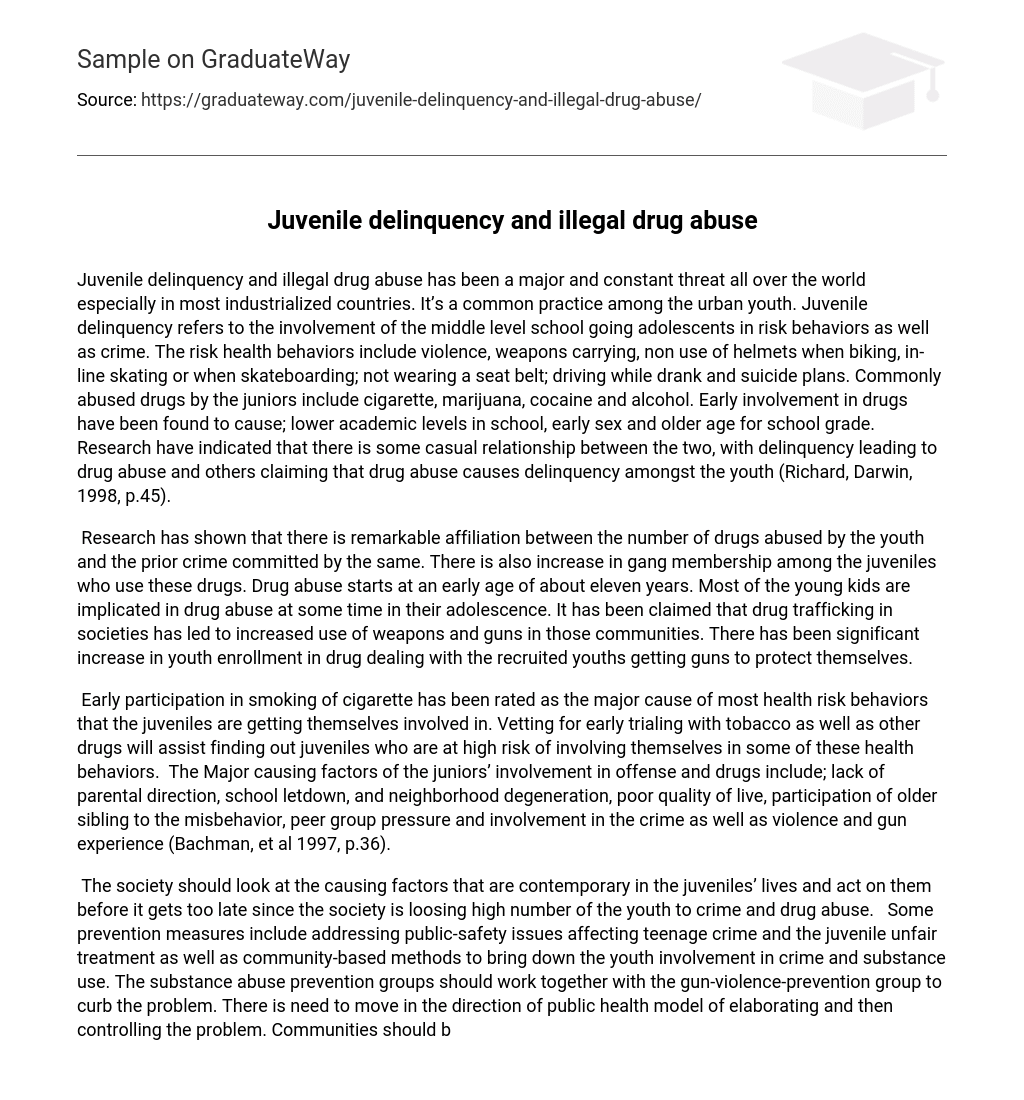Juvenile delinquency and illegal drug abuse has been a major and constant threat all over the world especially in most industrialized countries. It’s a common practice among the urban youth. Juvenile delinquency refers to the involvement of the middle level school going adolescents in risk behaviors as well as crime. The risk health behaviors include violence, weapons carrying, non use of helmets when biking, in-line skating or when skateboarding; not wearing a seat belt; driving while drank and suicide plans. Commonly abused drugs by the juniors include cigarette, marijuana, cocaine and alcohol. Early involvement in drugs have been found to cause; lower academic levels in school, early sex and older age for school grade. Research have indicated that there is some casual relationship between the two, with delinquency leading to drug abuse and others claiming that drug abuse causes delinquency amongst the youth (Richard, Darwin, 1998, p.45).
Research has shown that there is remarkable affiliation between the number of drugs abused by the youth and the prior crime committed by the same. There is also increase in gang membership among the juveniles who use these drugs. Drug abuse starts at an early age of about eleven years. Most of the young kids are implicated in drug abuse at some time in their adolescence. It has been claimed that drug trafficking in societies has led to increased use of weapons and guns in those communities. There has been significant increase in youth enrollment in drug dealing with the recruited youths getting guns to protect themselves.
Early participation in smoking of cigarette has been rated as the major cause of most health risk behaviors that the juveniles are getting themselves involved in. Vetting for early trialing with tobacco as well as other drugs will assist finding out juveniles who are at high risk of involving themselves in some of these health behaviors. The Major causing factors of the juniors’ involvement in offense and drugs include; lack of parental direction, school letdown, and neighborhood degeneration, poor quality of live, participation of older sibling to the misbehavior, peer group pressure and involvement in the crime as well as violence and gun experience (Bachman, et al 1997, p.36).
The society should look at the causing factors that are contemporary in the juveniles’ lives and act on them before it gets too late since the society is loosing high number of the youth to crime and drug abuse. Some prevention measures include addressing public-safety issues affecting teenage crime and the juvenile unfair treatment as well as community-based methods to bring down the youth involvement in crime and substance use. The substance abuse prevention groups should work together with the gun-violence-prevention group to curb the problem. There is need to move in the direction of public health model of elaborating and then controlling the problem. Communities should be using multi-displinary teams that epitomize mental health, substance use, criminal integrity, the law enforcement agents, social services, education to find out and critically scrutinize the causing factors and their solutions then deal with them accordingly (Jenkins, Zunguze, 1998, p.23).
This approach however has challenges including; it takes time cooperate the different disciplines; it also takes a lot of time to train and create a better program which can make difference. This can take duration of about one or two years. In spite of these challenges this is still the most appropriate way to use as a long term solution to curb this juvenile delinquency, drug abuse as well as their subsequent victimization.
Reference
Bachman Jerald, et al (1997) Smoking, Drinking, and Drug Use in Young Adulthood: The Impacts of New Freedoms and New Responsibilities. New York: Lawrence Erlbaum Associates, pp.36
Jenkins Jeanne & Zunguze Sabina (1998) The Relationship of Family Structure to Adolescent Drug Use, Peer Affiliation and Perception of Peer Acceptance of Drug Use. Adolescence, Vol.33, pp.23
Richard Isralowitz & Darwin Telias (1998). Drug Use, Policy, and Management. Mahwah, NJ: Praeger Publishers, pp.45





